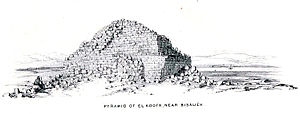Pyramid of el-Kula
| Pyramid of el-Kula | ||||||||||||||||||||
|---|---|---|---|---|---|---|---|---|---|---|---|---|---|---|---|---|---|---|---|---|
|
Drawing of the pyramid of el-Kula after Perring, 1842
|
||||||||||||||||||||
The pyramid of el-Kula belongs together with the pyramids in Edfu-Süd , Elephantine , Ombos , Saujet el-Meitin , Seila and Sinki to a group of a total of seven very similar small step pyramids , all of which were erected far away from the great centers of Egypt and over which is very little known. It is located about six kilometers north of the ancient Hierakonpolis near the village of Naga el-Mamariya. Of all the above pyramids, it has the best state of preservation. It was first described in 1837 by John Shae Perring and Richard William Howard Vyse , who, however, referred to it as el-Koofa. A thorough excavation and investigation of the structure took place in 1949 under the direction of the Belgian Egyptologist Jean Capart .
Data
The pyramid consists of three steps and has a side length of 18.60 meters. Its height is still 8.25 meters today, Perring and Vyse were 11.75 meters in the middle of the 19th century. It consists of a core structure with a side length of about 10.20 meters, around which two shells, each 4.5 ells thick, are arranged. A special feature of this pyramid is that its sides are not oriented towards the cardinal points, as is usually the case with Egyptian pyramids, but their corners. The explanation for this lies in the fact that its east side is based on the course of the Nile , which flows almost exactly to the northwest at this point. Limestone of local origin was used as building material. The individual blocks are roughly hewn and measure up to 60 by 100 cm. They are piled up in layers of stone with an average thickness of 35 cm. A mixture of clay, Nile mud, sand and small limestone fragments served as mortar.
On the north-west side there is a cut about eight meters deep, which was made at the end of the 19th century to get to a presumed burial chamber, which, however, does not exist. It is unclear who created this pattern, it was partly attributed to Gaston Maspero , who dug around 1900 in el-Kula, and partly to Edouard Naville , who worked there in 1884. However, the cut can already be seen on a photo that, according to Maspero, was taken in 1882.
Edification and function
The builder and function of the pyramid are unknown. Günter Dreyer and Werner Kaiser consider them, as well as the other pyramids mentioned above, to be a coherent building project by Pharaoh Huni , the last ruler of the 3rd dynasty. Andrzej Ćwiek sees this in a similar way, but suspects Huni's successor Sneferu (around 2670–2620 BC), the founder of the 4th dynasty , as the builder . Speculations about the function of the pyramids range from a representation of the king to a representation of the original hill or a symbol of the political and religious unity of the country to cenotaphs of the royal wives.
The American Robert E. Womack published a completely different theory in 1994 . He sees the pyramid of el-Kula as evidence of the Mesopotamian influence on Egypt and justifies this with the fact that the corners and not the sides of the pyramid are oriented towards the cardinal points, as is also true of the Mesopotamian ziggurats . Although there were apparently very intensive relationships between the two cultures in the pre- and early dynastic period , Womack's theory found no support among Egyptologists, as the orientation of the pyramid was very likely based on the course of the Nile, as it was with the other six pyramids in this group of Case is.
literature
- Jan Bock: The small step pyramids of the early Old Kingdom. In: Sokar. No. 12, 1/2006, pp. 20-29.
- Andrzej Ćwiek: Date and Function of the so-called Minor Step Pyramids . In: Göttinger Miszellen Vol. 162, Göttingen 1998, pp. 39-52 ( online ).
- Günter Dreyer and Werner Kaiser: To the small step pyramids of Upper and Central Egypt . In: Communications from the German Archaeological Institute, Cairo Department. (MDAIK) Volume 36, von Zabern, Mainz 1980, pp. 45f.
- Mark Lehner : The Secret of the Pyramids in Egypt. Orbis, Munich 1999, ISBN 3-572-01039-X , p. 96.
- John S. Perring, Samuel Birch, EJ Andrews: The Pyramids of Gizeh. Volume III, Fraser, London 1842.
- Ali Radwan: The step pyramids. In: Zahi Hawass (ed.): The treasures of the pyramids. Weltbild, Augsburg 2004, ISBN 3-8289-0809-8 , p. 111.
- Miroslav Verner : The pyramids (= rororo non-fiction book. Volume 60890). Rowohlt, Reinbek bei Hamburg 1999, ISBN 3-499-60890-1 , pp. 198f.
- Robert E. Womack: The Pyramid at El Kula: Could it be additional evidence of early Mesopotamian influence? In: KMT: a modern journal of ancient Egypt. (KMT) Number 5/2, San Francisco 1994, pp. 65-69.
Web links
Coordinates: 25 ° 8 ′ 0.3 ″ N , 32 ° 44 ′ 0.4 ″ E
